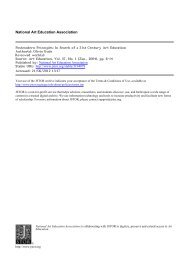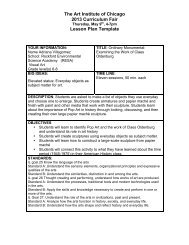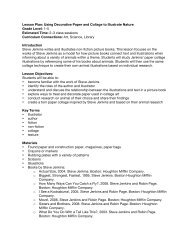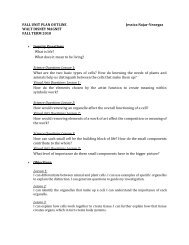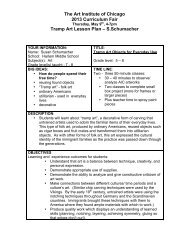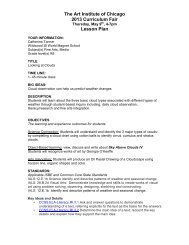Lesson 1 - LearningThroughMuseums
Lesson 1 - LearningThroughMuseums
Lesson 1 - LearningThroughMuseums
Create successful ePaper yourself
Turn your PDF publications into a flip-book with our unique Google optimized e-Paper software.
<strong>Lesson</strong> 3<br />
People and Environments of the American West<br />
Summary<br />
In this lesson, students apply skills of reading to interpret how two different works of art represent the<br />
western United States. They learn about two art forms—sculpture and painting—and then create their<br />
own artwork and write a poem to communicate about people in an environment.<br />
Featured Artworks<br />
Frederic Remington (American, 1861–1909)<br />
The Bronco Buster, modeled 1895; cast 1899<br />
Cast by Henry‒Bonnard Bronze Co.<br />
Bronze with brown patina<br />
Marsden Hartley (American, 1877–1943)<br />
The Last of New England—The Beginning of New Mexico, 1918/1919<br />
Oil on cardboard<br />
Illinois Benchmarks<br />
Reading<br />
1.A.2b:<br />
1.B.2a:<br />
1.C.2e:<br />
1.C.2b:<br />
Writing<br />
3.B.2a:<br />
3.C.2a:<br />
Clarify word meaning using context clues.<br />
Establish purposes for reading: survey materials; ask questions; make predictions;<br />
connect, clarify, and extend ideas.<br />
Explain how authors and illustrators use text and art to express their ideas.<br />
Make and support inferences and form interpretations about ideas and topics.<br />
Generate and organize ideas using a variety of planning strategies.<br />
Write for a variety of purposes and for specified audiences in a variety of forms.<br />
Social Studies<br />
17.C.2a: Describe how natural events in the physical environment affect human activities.<br />
18.A.2: Explain ways in which artistic creations communicate about a culture.<br />
Art<br />
25.B.2: Understand how elements and principles combine within an art form to express ideas.<br />
25.A.2d: Identify and describe the elements of two‒ and three‒dimensional space, figure‒ground,<br />
value and form; the principles of rhythm, size, proportion and composition; and the<br />
48 • <strong>Lesson</strong> 3: People and Environments of the American West



